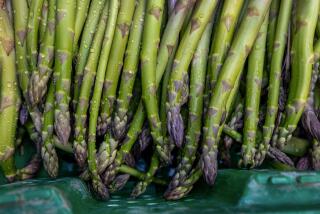The Perennial Stalk of the Town: Asparagus
With most vegetables, by the time you taste them fresh-picked, it’s too late in the season to plant them in your garden.
Not so with asparagus. Borrow a taste from a neighbor’s asparagus bed or from a wild clump growing along a fence row, and you are likely to want some growing outside your own back door.
Minutes-old asparagus tastes different--and better--than any asparagus that reaches the markets.
Asparagus is a perennial, so the main thing year after year is to pick it. An established planting can reward you with tender green spears for half a century or more.
Set asparagus off to one side of your garden, out of the way of other vegetables. Or plant it outside the vegetable garden, using the lacy, green foliage as a backdrop for perennial flowers or to soften the line of a wall or fence.
Gardeners with patience sow seeds; others buy roots and begin harvesting a year earlier. Seed sowing is straightforward, except that asparagus germination is slow. Soak the seeds in water for a few hours before sowing to shorten germination time.
The best roots to purchase are 1 year old. The fleshy roots radiate from the central crown, on which small buds--future spears--are evident. Plant the crown with these buds pointing upward, setting the crowns about 18 inches apart in rows 4 feet apart.
The traditional method for planting an asparagus bed entailed digging a trench a foot or more deep, setting the roots in the bottom with a covering of a shovelful of soil, then filling in the trench gradually as the stalks grew.
The main reasons for the traditional deep planting were to protect the crowns from overzealous hoes during tillage and from knives during harvest.
But if you keep weeds in check with an annual blanket of leaves or some other organic mulch, and harvest by merely snapping the stalks off with your fingers, the holes for your asparagus crowns need to be dug only deep enough to give the crowns a thin cover of soil.
Although asparagus roots stay alive year after year, their feathery tops turn brown and die back to the ground every fall. When the spring sun warms the soil, energy stored in the roots fuels growth of new spears. As the spears grow higher and higher, feathery green branches unfold, fueling roots for the coming year.
When we harvest asparagus, we steal some of the energy stored in the roots. The plant must build adequate reserves before tender stalks can be spared for our plates, so do not harvest any asparagus the first season of planting.
If good growth was made the first season, you can harvest some spears the second season. The plants are ready for a full harvest by the third season. Full harvest means cutting the stalks for about two months, then letting the leaves grow and do their job of nourishing roots in preparation for winter. Cut them after they brown in fall.
The steaming dish of asparagus on your table today is virtually identical to that enjoyed by Greeks and Romans more than 2,000 years ago. Asparagus was native to the shores of the Mediterranean before it was transplanted to Greek and Roman gardens.
Asparagus was brought to America with the early colonists. The red berries borne on female plants attract birds that spread the seed, so asparagus now pops up as an “escape” from cultivation along fence rows and roadsides.
More to Read
Eat your way across L.A.
Get our weekly Tasting Notes newsletter for reviews, news and more.
You may occasionally receive promotional content from the Los Angeles Times.










